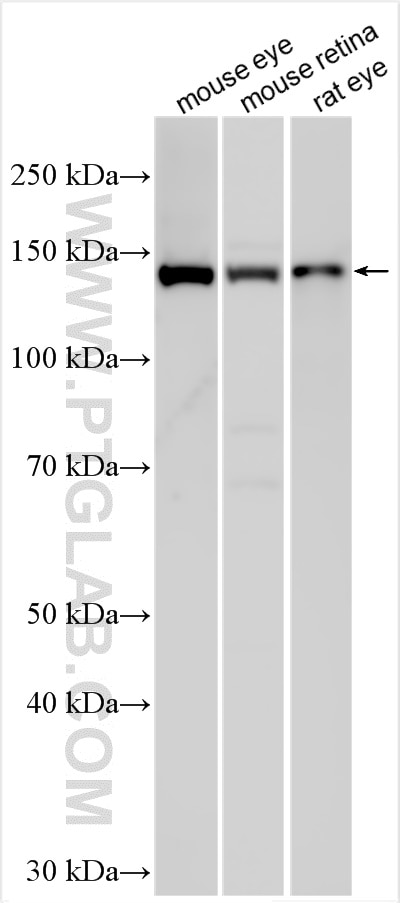Tested Applications
| Positive WB detected in | mouse eye tissue, mouse retina tissue, rat eye tissue |
Recommended dilution
| Application | Dilution |
|---|---|
| Western Blot (WB) | WB : 1:500-1:2000 |
| It is recommended that this reagent should be titrated in each testing system to obtain optimal results. | |
| Sample-dependent, Check data in validation data gallery. | |
Product Information
31187-1-AP targets PCARE in WB, ELISA applications and shows reactivity with Human, mouse, rat samples.
| Tested Reactivity | Human, mouse, rat |
| Host / Isotype | Rabbit / IgG |
| Class | Polyclonal |
| Type | Antibody |
| Immunogen | PCARE fusion protein Ag34774 Predict reactive species |
| Full Name | chromosome 2 open reading frame 71 |
| Calculated Molecular Weight | 140 kDa |
| Observed Molecular Weight | 140 kDa |
| GenBank Accession Number | NM_001029883 |
| Gene Symbol | PCARE |
| Gene ID (NCBI) | 388939 |
| RRID | AB_3669889 |
| Conjugate | Unconjugated |
| Form | Liquid |
| Purification Method | Antigen affinity Purification |
| UNIPROT ID | A6NGG8 |
| Storage Buffer | PBS with 0.02% sodium azide and 50% glycerol, pH 7.3. |
| Storage Conditions | Store at -20°C. Stable for one year after shipment. Aliquoting is unnecessary for -20oC storage. 20ul sizes contain 0.1% BSA. |
Background Information
C2orf71/PCARE (photoreceptor cilium actin regulator) is a retina-specific protein consisting of 1289 amino acids with a predicted molecular weight of 140 kDa. PCARE is predicted to be myristoylated and palmitoylated at its N terminus and plays an important role in delivering actin-associated components to the base of the photoreceptor OSs to regulate the initial development of OS disks (PMID: 32312818, 35253837).
Protocols
| Product Specific Protocols | |
|---|---|
| WB protocol for PCARE antibody 31187-1-AP | Download protocol |
| Standard Protocols | |
|---|---|
| Click here to view our Standard Protocols |



